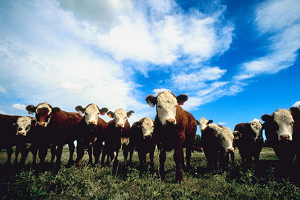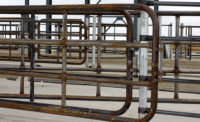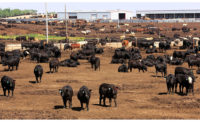Over the past decade, animal welfare has become an increasingly important concept in the meat industry. The viability of a slaughter plant depends in part on the ability of its employees to safely and effectively move and stun animals. Consumers and restaurant companies have come to expect that slaughter establishments maintain a high level of regard for animal welfare — and the industry has stepped up the challenge.

|
To prove this point, we can turn to data that has been collected by Dr. Temple Grandin, professor of Animal Sciences at Colorado State University. Her data reveals the importance of one of her favorite sayings: “You manage what you measure.”
Since 1999, Dr. Grandin has collected annual benchmark data on the performance of approximately 35 beef and 20 pork slaughter plants that supply major U.S. restaurant chains. She posts an annual summary on her Web site, www.grandin.com. With 12 years of data in the books, it is obvious that the beef and pork industries have developed a commitment to animal welfare. The improvement over little more than a decade is remarkable.
In 1996, Dr. Grandin conducted a survey of humane livestock handling and slaughter in 41 beef and 19 pork slaughter establishments. She found that only 30% of beef plants were able to render 95% or more of cattle unconscious on the first attempt in that survey, but her follow up survey in 1999 revealed that 90% of beef slaughter facilities were able to render more than 95% of cattle unconscious on the first attempt.
In 2010, she evaluated the performance of 30 U.S. beef slaughter facilities and reported that 100% of the plants successfully stunned 95% or more of their cattle on the first attempt. Of the 30 plants that were evaluated, 23 successfully stunned 99% or more of their cattle on the first attempt. Over the time period from 1999 to 2010, 50% of pork slaughter facilities eliminated the use of electric prods to move pigs. Over the same time period, 22% of beef slaughter establishments eliminated electric prod usage.
Much of the success in improving animal welfare in beef and pork slaughter plants can be attributed to two major factors.
The first is the use of animal-welfare auditing as an objective tool to track the performance of livestock handlers and stunner operators. Such audits have become commonplace in larger slaughter establishments because many of their customers require assurance that their suppliers are maintaining an acceptable level of animal welfare.
The second factor is the development of a culture within the plants that truly cares about animal welfare. In most cases, this sentiment toward handling and slaughtering animals with a continuous focus on improvement comes from the management and permeates the entire facility.
Many plants have begun to use remote video auditing of their livestock handling and stunning operations. Remote video auditing is performed by an off-site trained animal-welfare auditor over a secure Internet connection using video cameras that are mounted within the handling and stunning facilities. These systems have proven to be very useful in monitoring day-to-day and hour-to-hour animal handling and stunning within plants.
With remote video auditing, the times when an auditor is watching are random throughout the day, so the plant employees do not know when they are being audited. The scores of the random audits are immediately emailed to plant personnel after the audit is completed, so the feedback from remote video audits is quickly usable for plant management and supervisors. The plants that have started to use remote video auditing have recognized improvement in the consistency of performance in animal handling and stunning within their facilities.
The sustained focus on improvement in animal handling and stunning that has been demonstrated by the beef and pork sectors over the past 12 years has resulted in significant improvements in animal welfare in slaughter facilities. The heightened interest in animal welfare within the industry has also been remarkable.
In 1999, the American Meat Institute offered their first Animal Care and Handling Conference. Since 1999, the conference has nearly doubled in attendance. This year’s conference is scheduled for October 19-21 in Kansas City.
In order to maintain consumer trust, we must continue to find ways to maintain a high level of performance in animal welfare and handling throughout the industry. The formula for success is simple:
1) Continue to focus on collecting accurate performance data that can be used to identify areas where improvement is necessary, and
2) Continue to use the data to develop and nourish a focus on excellence in humane livestock handling and slaughter.
Kurt D. Vogel, Ph.D. is an assistant professor of animal science with an emphasis in livestock behavior and welfare at the University of Wisconsin - River Falls. He is also the president of Vogel Livestock Solutions, an animal-welfare consulting agency. For more information, contact him at kurt.vogel@uwrf.edu or (715) 425-3704.






Report Abusive Comment